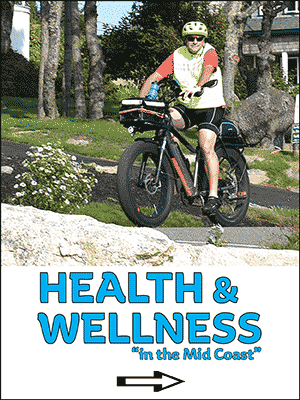Kitchen Medicine — An Herbal Experience at Rising Tide
Long ago. In her father’s library at the house in Bremen, Anina pulls a book from the shelf. Of all of the books in a room stacked floor to ceiling with them, she finds “Back to Eden,” a guide to herbal medicine, natural foods, and home remedies, written in 1939 by Jethro Kloss. This is the book Anina returns to whenever she can during her teenage years, captivated by its radical theories on holistic health. Beyond the library window, the natural world is alive to Anina — the fields, the cove, and her father’s garden, a tangle of medicinal secrets that she is drawn to but has yet to fully understand.
In a city far away, Amy might also at that very moment be turning the worn pages of a childhood favorite as she settles into the pillows of the sofa in her own father’s library. The room is dark and quiet, far removed from the river of yellow taxis that separates it from Central Park. Amy finds the park enthralling, filled with sweeping trees and hidden gardens. She has always liked to imagine Stuart Little’s friend Margalo building her nest in a Boston fern just across the way.
This is the story of two herbalists who meet in Maine thirty years later.
Anina’s early fascination with medicinal herbalism became a life passion, taking her from Maine to Belize, where she studied the herbal traditions of Mayan and Garifuna communities. She found work as an herbal apprentice in Ridgeway, Colorado, learning to harvest, dry, and process herbs. Returning to Maine, Anina began to tinker with making her own products before completing the program at Earthwalk School for Herbal Medicine in Rockport. Anina is now nine years into her role at Rising Tide Co-op in Damariscotta, where she sources the wellness department with local products.
Amy’s journey began as a search for alternatives to traditional diagnoses of the health disturbances and imbalances that plagued her as a young adult. Amy was drawn to the theories of integrative health and holistic body systems that offered a different path. Along the way, she began to prioritize an organic and ethically-sourced diet. She joined Herbalists Without Borders to introduce natural wellness to communities in need, including those suffering because of trauma or serious illness, even cancer. Amy describes her life today as “truly nourished.”
So, it’s no surprise that when she arrives in Maine for a visit, Amy floats in like a modern-day Mary Poppins, my favorite heroine, carrying an enormous satchel overflowing with an endless number of unmarked bottles, mysterious tinctures, and suspicious salves. She pulls out a half dozen little bags of herbs, filling the house with the scent of hay and clove. Also, a big bottle of castor oil, which, if I’m being honest, is immediately concerning. I just don’t see Amy offering a spoonful of sugar to help the medicine go down.
I suggest a road trip as a distraction. We wind our way out of town towards River Road, going north. Along the way, Amy easily resists the temptation to try flavored popcorn. We make it safely past Dunkin Donuts. Whoopie Pies? Thank you, no. Finally, in Damariscotta, Amy finds her kindred.
Going to Rising Tide Co-op with Amy is like going to the bookstore with my sister. You think you’ll pop in for a quick minute and the next thing you know you’ve been there for three hours. Suddenly oblivious to further plans for the day, we explore the aisles of Rising Tide, looking for ingredients for Amy’s favorite recipes, but remaining open to whatever catches her eye. I become obsessed with the novelty of grinding fresh cashews, almonds and peanuts into butter. And so many seeds to choose from! We decide to make crackers with pumpkin, flax, and sunflower seeds. We find the most beautiful head of lettuce that I’ve ever seen. We are picking up steam.
Then, rounding the corner towards the cashier, Amy arrives at the wellness shelves. Which brings her to a standstill. It turns out there are more than 300 natural products to consider. Each is a revelation. Amy is particularly awed by the products sourced from local herbalists. She gathers Blue Tansy and Mint lip balms from Holmes & Hudson. Some bottles of elderberry syrup from Maine Medicinals. Cucumber arthritis treatments from Coastal Bio Resources. Tonics and shrubs from Herbal Revolution. Trillium soaps and medicinal Lion’s Mane tincture from North Spore Mushrooms.
Which is how we put in motion the aforementioned introduction. Anina and Amy become fast friends within a matter of minutes, speaking a language I cannot quite translate. They bond in excitement over innovations in herbalism, as well as in their shared indignation at companies professing products to be natural but actually filled with synthetic ingredients. Amy enlists Anina for Herbalists without Borders, describing the mobile clinic she runs in New York to provide access to organic and nutritious products for vulnerable communities. It’s all about “how we care for each and honor what is needed,” they agree. By this point they are deep in conversation about the foundations for a good herbal kitchen, including the need to buy organic whenever possible and ways to store food — everything in glass jars lined with remnants of kitchen towels to absorb moisture.
As we talk further about the idea for a column, we meet Haidan, Rising Tide’s Marketing Manager, who lives and breathes the Co-op’s mission as a community hub where making wellness accessible is a central tenet. Haidan facilitates engagement with the community, inviting member owners and customers to volunteer for food drives and support events like “Loving Local Meals,” and “Co-op for Community” Day. Rising Tide embraces the principles of a cooperative, including an “all are welcome” ethos, a democrative process in which members make decisions and contribute to the health of the organization, cooperation with other similar co-op organizations, and a commitment to the sustainable development of community.
Haidan’s own story includes an early introduction by “hippie” parents to health foods while living outside of Boston, and a prior avocation pairing young people with working artists to create public art installations. We do a little bonding of our own.
As we speak, Haidan is preparing small packets of ginger, sourced from Gryffen Ridge Spice Merchants, to donate to the Skidompha Library’s new “Spice of Life Take and Make” series. Each month, the library features a different spice, offering recipes and educational materials on the medicinal qualities of the featured spice. Hearing this, we double back to find fresh ginger, eager to experience its benefits to cognitive function, relief for arthritis, and an end to stress and anxiety.
The trunk of the car is filled to the brim, but I’m hung up on something. I’m curious about the fathers in this story. Are they aware of the role they played in seeding their daughters’ paths to herbalism as a profession? Have they incorporated these principles into their own lives? I’m told Anina’s father remains an active gardener. Amy’s, who spent years living across from a park but never really engaging with it, learned through daily walks during the pandemic to “breathe in nature.” Meditation and herbal remedies are now daily rituals. Like daughter like father.
We head home to cook. Perhaps on our way we will pop in at the Skidompha Library, just for a minute.
Amy’s Seed Crackers
One cup each of pumpkin, flax and sunflower seeds, with some crushed nuts mixed in. 1/4 cup each of hemp hearts, chia seeds, and sesame seeds. 4 T. psyllium seed husk. Salt, olive oil, filtered water.
Mix dry ingredients and add 1/3 c. oil. Add water just until the mixture holds together. Flatten dough on a silicone-lined baking sheet and leave overnight. Bake 20 minutes at 350 degrees. Flip and bake for 20 more minutes until nuts and seeds begin to brown. Cut and store in the refrigerator (for up to 2 weeks) or the freezer 9for up to 6 months).
































